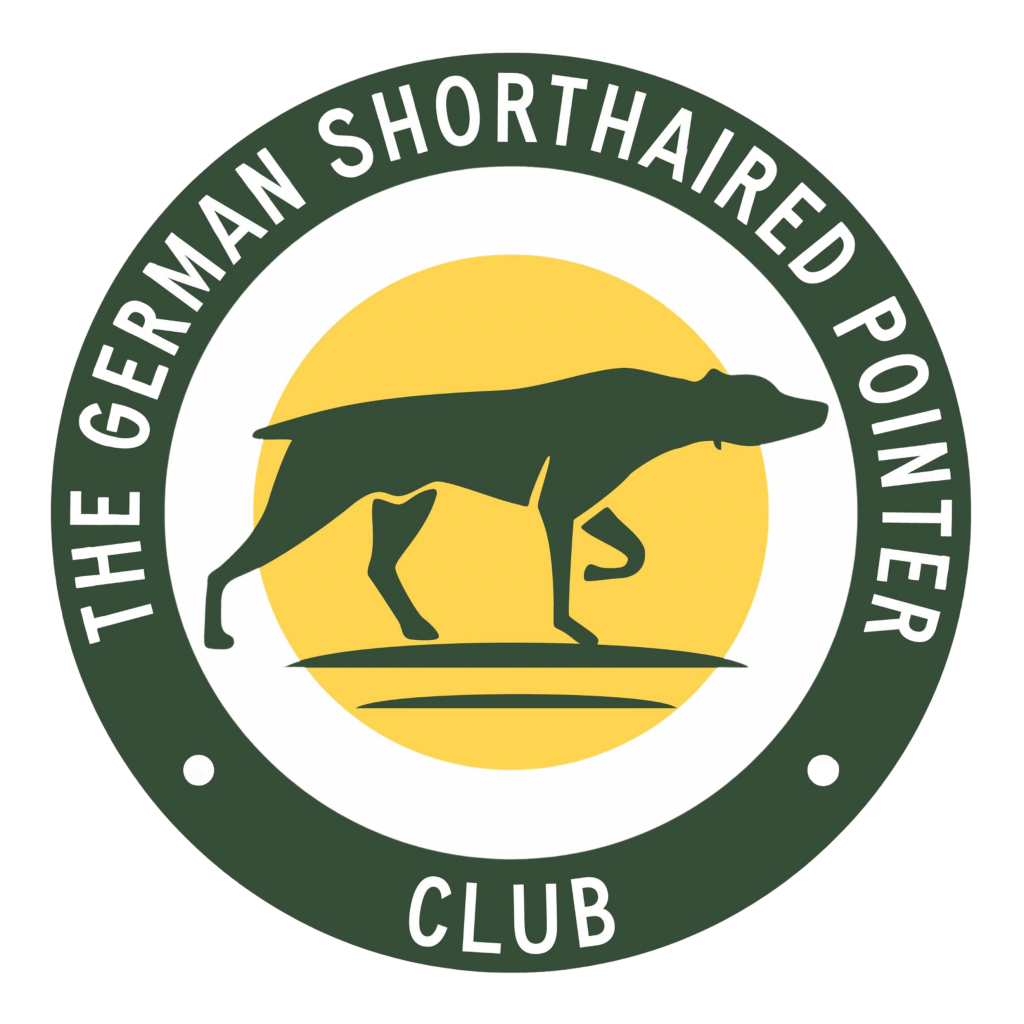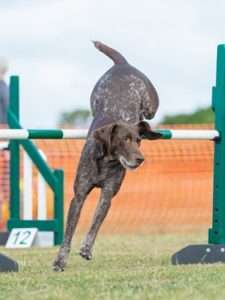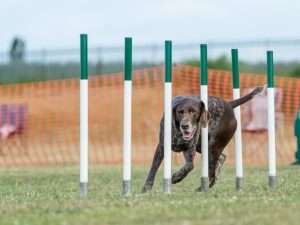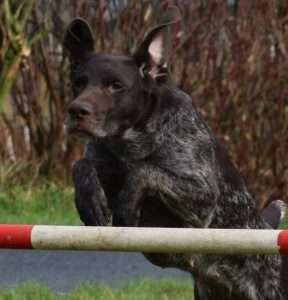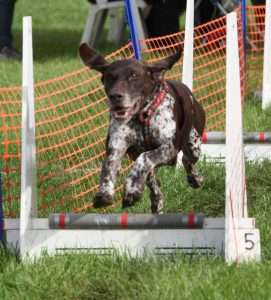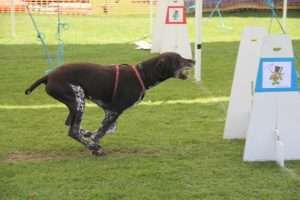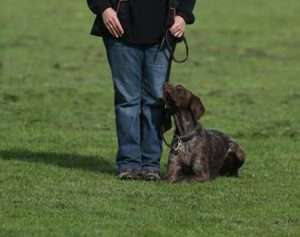Agility
This sport is hugely popular in the UK with almost any type of dog being suitable so long as the dog is relatively fit, healthy and agile, therefore it suits the German Shorthaired Pointer very well. As a handler you have to be fairly fit as well as you have to keep up with your dog.
The animal must be at least 12 months old and physically mature before any serious training can begin. The UK Kennel Club regulations state that a dog may not be entered in competition before it is 18 months of age. Dogs of any size can successfully take part in agility, from Yorkshire Terriers to Great Danes with the height of the obstacles set in relation to the dog’s size. Any dog over 17 inches at the withers (shoulders) would jump a maximum height of 2ft 6ins .This height is nothing for your normal German Shorthaired Pointer; in fact they would sail over it.
To begin agility your dog needs to have some basic obedience skills such as “sit”, “wait” and a recall. The more advanced directional signals can be learnt as the dog progresses. Your dog will eventually be working off the lead, therefore it is necessary for your dog to be OK with other dogs, although dogs run singly in competition so as long as you can control your dog this is not so vital unless you are going to compete with dogs as a team.
There are a wide range of obstacles which your dog has to learn; some easy some not so easy. There are tunnels, both the open type and ones the dog has to push open as it goes through. Jumps aren’t difficult except there is only a rail on the top of the jump so you must teach your dog not to go underneath. There are also obstacles that have contact points which your dog must touch. The “A” frame, Dog Walk and Seesaw are such obstacles therefore training with a reputable club is very important to teach both you and your dog to negotiate each obstacle correctly and safely whilst still maintaining fun and enjoyment for both handler and dog.
Agility is a competitive sport with courses run against the clock, although accuracy is just as important as speed! However you do not have to compete to enjoy agility indeed many people young and old take their dogs along to agility just to have fun. It is also a great way to keep both your dog and yourself fit.
So if you fancy giving agility a go, contact your local dog training club or The Kennel Club to find your nearest club, who should be happy to help you and provide you with more information. Go on treat yourself and your dog to some fun.
Flyball
Before you can consider flyball there are a few questions you have to ask yourself.
- Is my dog fit and agile?
- Does my dog like to retrieve tennis balls?
- Can my dog jump a foot high?
If your German Shorthaired Pointer is like any I know then the answer is yes, yes and yes, then you’re halfway there.
The basic idea is to send your dog in a straight line over four hurdles to hit a pedal on a box which then throws a tennis ball into the air which your dog has to catch (or not) and then return to you over the same four hurdles with the ball in its mouth. It sounds easy but don’t be fooled. There are many tricks your dog can play on you. Once your dog understands the game then I’m sure like anything else a German Shorthaired Pointer does, it will give it’s all.
Flyball is a team event like a relay race with four dogs per team (so your dog must be OK with other dogs). It is also a speed game. When you get to competition level your team will compete against another team and the fastest one wins. As with most of these types of activity there are a lot of collie type dogs taking part, but any dog that is active and keen can become very good. It is a lot of fun and I’m sure your GSP will love it. Mine certainly does.
To find your nearest club ask at your local dog training club or vets. If not, then the Kennel Club has a list of all registered clubs. So go on have a go and I’m sure you and your dog will have great fun.
Nicky Hamlin
Obedience
All dogs benefit from some form of obedience this includes a GSP. If nothing else you want a well behaved companion. As soon as you make the decision to have a dog, it is worth looking up local dog training clubs. Your vet may know of some or The Kennel Club also has a list of registered clubs. Go and visit them and see what method of training they use; if you don’t like it, try another club. There are many very good clubs out there but there are a few bad ones, so it’s better to find out before you take your puppy along.
A lot of good clubs run puppy classes, which are more like a playgroup; your puppy does a bit of learning and a bit of play. These training clubs sometimes have a waiting list so it is worth booking early. You want to start as soon as you can and this will also help to have a well-socialised puppy. GSPs are very intelligent dogs and can take to obedience very well if you find the right motivation; they are usually keen to learn. The basics of obedience will be to teach your dog to walk by your side without pulling, to come when called, to stay in a set position (sit, stand & lying down), retrieve and scent discrimination, everything else can be based on these. Most important of all, remember, it should be fun for you but most of all it must be fun for your dog. Once you have got the basics why not try a competition, you can start with exemption shows and if you enjoy it why not try to work up. Good luck; that first trophy will be unforgettable.
Nicky Hamlin
